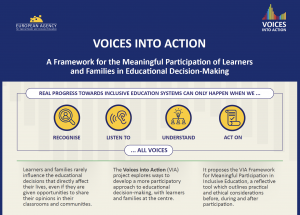This area contains multimedia materials including key messages, presentations and links to videos from the EASNIE YouTube channel.
Changing Role of Specialist Provision in Supporting Inclusive Education: Policy Self-Review Tool
This video introduces the CROSP Policy Self-Review Tool, the main outcome of phase 2 of the activity, and gives guidance on how to use the tool.
Voices into Action: Including the voices of learners and families in educational decision-making
The Voices into Action (VIA) activity examined the critical issue of involving the voices of learners and their families and how to effectively include them in decision-making.
Teacher Professional Learning for Inclusion: From project to profile
The TPL4I activity aimed to develop a policy framework for preparing all teachers to include all learners and revisited the earlier Profile of Inclusive Teachers to develop a competence framework for all education professionals involved in inclusive education.
Infographic: Voices into Action

This infographic, available in all Agency languages, was developed as part of the Voices into Action (VIA) activity. It presents the VIA Framework for Meaningful Participation in Inclusive Education. Policy-makers, school leaders, teachers and other stakeholders can use the framework to encourage meaningful participation of learners and families in educational decision‑making across all education levels.
